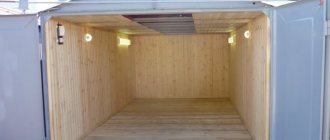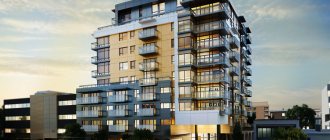Competent development of fire safety instructions, taking into account the individual characteristics of a particular facility, is important. The chances of an uncontrolled fire increasing significantly if the rules are drawn up “superficially”. This increases the risk of harm to human health and property. In order to prevent accidental fires, it is important to be able to correctly determine the structural and functional purpose of buildings in terms of fire safety.
Each building in turn is divided into the following indicators:
- constructive - this parameter depends on many factors: the area and height of the building, the direction of activity, what class of functional fire hazard the industrial or warehouse buildings and other types of objects belong to
- functional - the parameter directly depends on the direction of activity carried out in the structure in question. The functional fire hazard class of a building and its parts is determined taking into account the level of safety of technological operations that can provoke a fire. The number of people for whom the building is intended is also taken into account.
Why are public buildings called public buildings?
A feature of public buildings that distinguishes them functionally from residential buildings is the massive simultaneous presence of people in them. These are, for example, entertainment and sports buildings, educational, cultural and educational, shopping, etc.
Interesting materials:
When is the full moon? When does the waxing moon occur in November? When is furosemide prescribed? When is Riboxin prescribed? When is the Psalter for the Dead not read? When is personal income tax not paid? When should you not commemorate? When is it forbidden to get married according to the Orthodox calendar? When is it necessary to provide sick leave to the employer? When is it necessary to carry out an inventory?
What are these buildings?
The current legislation of the Russian Federation does not provide a clear explanation of the terms “purpose of premises” and “functional purpose of premises”.
Reference! According to sub. 3 clause 36 of block 3.5 of the procedure for maintaining the Unified State Register of Real Estate, approved by order of the Ministry of Economic Development of the Russian Federation dated December 16, 2015 No. 943, there is a division of all premises into two types: non-residential and residential.
The provisions of the Unified State Register determine the types of permitted use of a particular object. Previously, the functional purpose of a non-residential building was necessarily indicated in the design documentation. But at present, the Law “On Participation in Shared Construction” dated December 30, 2004 No. 214-FZ no longer contains a mandatory requirement to include in the information about a construction project information about the functional purpose of non-residential buildings that do not belong to common property.
The Civil and Housing Code of the Russian Federation, as well as Federal Law of the Russian Federation No. 218 dated July 13, 2015, provide the main criteria for non-residential premises, which also meet the requirements for a residential building, namely:
- The object must be immovable and isolated, its boundaries are the floor, ceiling, walls.
- There must be an entrance to such a building.
- The immovable nature of the object is due to the fact that it is part of a building located on a specific plot of land.
- It can also be located in residential and non-residential buildings, but the premises themselves must be classified as non-residential.
The main difference between a non-residential property and a residential one is that it does not provide for permanent residence of people, and also that it is allowed to be used only for administrative, public, commercial and other purposes.
Most citizens do not distinguish between the legal status of common property and non-residential premises. The entrance, attic, elevator and basement are considered common areas. Non-residential premises in apartment buildings include cafes, shops, offices and other organizations. A special place is occupied by domestic non-residential premises in which there are studios, shops, and social welfare institutions.
Administrative buildings are structures united by a common architectural task, the main purpose of which is to create conditions for the functioning of the administrative apparatus of state, municipal and private enterprises, institutions and organizations.
Fire hazard of building materials
The fire hazard class of building materials also has its own sign.
It is brought to us by the same Technical Regulations on industrial safety requirements as amended by Federal Law No. 117-FZ dated July 10, 2012.
It looks like this.
As you can see, the fire hazard class depends on the combustion groups.
Classification designation from KM0 to KM5.
KM0, for example, generally refers to the safest type of material - it does not burn.
- Fire hazard class KM1 corresponds to combustion group G1, ignition group B1, toxicity T1, smoke generation D1, surface spread of fire - RP1.
- KM2 fire hazard class indicates that the building material allows the same groups of flammability, smoke generation ability, toxicity and flame propagation as KM1. But the flammability is different - B2. That is, this material is more dangerous for us in a fire.
- Fire hazard class 3 is already more flammable and toxic. Materials in this category also ignite more quickly.
- Fire hazard class 4 differs from the third in more toxic combustion products and a higher percentage of flammability of the substance.
- Materials of fire hazard class KM 5 are very flammable, flammable and toxic, and also support the rapid spread of fire. In buildings with such building materials, increased fire safety measures are required with the use of effective fire safety devices.
We now know the software classes of building materials.
Well, what next?
And then the most interesting part.
How to calculate the fire hazard class, for example, for flooring in a room with FPO F1.2 and a capacity of 500 people?
Very simple. This coating has a fire hazard class of KM2.
How is this clear?
- We take plate 29 from Technical Regulations 123-FZ.
- We find the appropriate capacity and functional software.
- We see that the flooring material has class KM2.
In a similar way, you and I can determine the class of a ceiling covering material with F2.1 for an indoor arena with a capacity of 150 people.
Here we will find KM1 fire hazard class.
Let's look at Table 28 of the same Technical Regulations.
Here are software classes for finishing and lining materials for evacuation passages.
Evacuation route with F4.2 and at building height
no more than 28 meters for covering the corridor floor provides fire hazard class 4.
Whereas the material for lining the walls of the escape route in the same structure assumes fire hazard class 3.
Let's look at another example.
Multi-storey residential building (F1.3) with a height of 20 floors.
If we want to put linoleum on some floor,
for example, in a common corridor, then the fire hazard class of linoleum should correspond to KM1,
according to the same 28th table 123-FZ.
In addition, clause 6.25 of SP 112.13330 says that on evacuation routes
It is unacceptable to use building materials for floor coverings
with a fire hazard index greater than the following.
- T2, RP2, B2, D3 – corridor passages, vestibules, foyers.
- RP2, G2, T2, D2 – staircases, halls, including elevators.
Based on these conditions, we understand that the software class of linoleum must be no lower than KM2, that is, KM1 or KM2.
KM3 class linoleum is allowed to be used.
But you can’t be 100% sure about linoleum of this class of software.
Rooms with wet processes
Among firefighting terms, the term “rooms with wet processes” is found [SP 5.13130.2009]. Premises with wet processes are exempt from protection by automatic fire extinguishing and fire alarm systems. However, a definition of this term is not given, which creates confusion and an unjustified underestimation of the degree of protection of such premises from fire. There are also no quantitative characteristics of indoor air humidity. As an example of rooms with wet processes, SP 5.13130.2009 provides showers, lavatories, refrigerated chambers, and washing rooms. Here there is a clear substitution of the concept of “room” with the concept of “process”. A bathroom is a room and there is no process in it. Due to the presence of a small open water surface in the bathroom, a slight increase in air humidity is possible. How can increased air humidity affect the need to equip a room with fire automatics? Maybe increased air humidity in the room eliminates the possibility of fire and stops the combustion process? Recognizing a slight increase in the ignition energy of combustible materials in an atmosphere with high humidity, one cannot conclude that there is any noticeable decrease in the rate of combustion of materials; rather, on the contrary, some materials in a humid atmosphere burn at a higher rate [Kumagai S. Combustion. Per. from Japanese. M.: Chemistry, 1980. 256 p.].
Is the expression “wet processes” even legitimate? In chemical technology there is the concept of “dry processes” - these are technological processes without the participation of a liquid phase of the “gas-gas”, “gas-solid” type [Chemist’s Handbook 21]. In contrast, processes involving the liquid phase can be called “wet processes.” But in this case we are not talking about them. The expression “rooms with wet processes” clearly has no meaning.
It remains to be assumed that the ban on the arrangement of premises “with wet processes” is associated with the corrosive activity of the humid atmosphere on the elements of fire automatics. Indeed, according to GOST R 53325-2012, clause 4.2.2.3, the fire detector must remain operational during and after exposure to increased relative air humidity of 93% at a temperature of 40 o C. This air humidity corresponds to the concept of “wet room mode” according to SP 50.13330 .2012. If we accept this condition, then instead of the expression “rooms with wet processes” we should write “rooms with a relative air humidity of more than 93% at 40 o C”, and appropriate changes should be made to the text of SP 5.13130.
What are there, list
Let us define built-in, attached, and detached non-residential buildings.
Reference! The legal status of built-in and attached premises is determined by “SP 31-107-2004. Architectural and planning solutions for multi-apartment residential buildings" (approved and recommended for use by Letter of the State Construction Committee of the Russian Federation dated April 28, 2004 No. LB-131/9).
- The built-in non-residential premises are located within the dimensions of a residential building with a protrusion beyond its boundaries of no more than 1.5 m.
- An attached part is a part of a building located outside the contour of its main external walls, which is auxiliary to the building and has one (or more) common main wall with it.
- Built-in and attached is a non-residential premises that is located within the dimensions of a residential building and in volumes extended beyond the dimensions of a residential building by more than 1.5 m.
In Russian legislation, the term “detached building” is not clearly defined by regulations. In legal practice, this term refers to an architectural object that is not united with another building by a common foundation and communications.
Classification by type of permitted use
Non-residential premises are adapted for various types of activities. There are the following types of buildings according to types of permitted use:
- Retail space used for trading activities. This category of buildings does not always have permanent walls, and may also consist of a small number of retail areas. It is mandatory to have basic communications systems nearby such an area.
- Office , used to furnish an organization's office. The main features of offices are the presence of capital walls separating it from other buildings. A prerequisite for an office is the presence of communication systems directly in the office (water supply, bathroom).
- Universal , designed for various types of business activities (office, medical office, gym, beauty salon).
- Stock. It is characterized by the presence of solid walls separating it from other premises. The presence of a separate entrance and basic communications is not important.
- Separate premises. This category of buildings has a separate entrance and main walls that separate it from other architectural objects. Communications are a must.
Functional fire hazard categories
Let's consider what functional fire hazard class theaters, schools, hospitals, railway stations and other institutions belong to. How many classes are there in total?
Class 1 – this includes residential buildings. They are operated on an ongoing basis and must be equipped with several independent options for escape routes. In addition, such facilities should be equipped with various fire barriers. Buildings in this group are characterized by the presence of rooms for rest and sleep. “F1” includes buildings where people live (temporarily, permanently), and they are divided into:
- F 1.1 – institutions for people with disabilities and preschool children (orphanages, hospitals, kindergartens)
- F 1.2 – institutions with temporary accommodation of people (hotels, sanatoriums, hostels for workers and students)
- F 1.3 – multi-apartment buildings (high-rise buildings)
- F 1.4 – individual housing building
Class 2 (F2) – establishments with a high level of traffic/attendance, various entertainment organizations that provide their services in open and closed spaces. This group includes:
- F 2.1 – buildings with seating for recreation (libraries, circuses, concert halls, etc.)
- F 2.2 – museums, various dance schools, facilities where exhibition events and fairs are organized
- F 2.3 – similar to F 2.1, but programs are held in open areas (stadiums)
- F 2.4 - similar to F 2.2, but there are programs taking place in open areas
Placement of signs at the facility,
class 3 – this includes structures operating in the area of public services:
- F 3.1 – shopping centers, hypermarkets;
- F 3.2 – canteens, dumplings (catering points);
- F 3.3 – stations, airports, seaports, station structures;
- F 3.4 – medical organizations providing services both at home and in institutions;
- F 3.5 – housing and communal services, savings banks, legal and notary organizations;
- F 3.6 – sports complexes, saunas, institutions where physical education and health programs are organized, etc.
Grade 4 – this category is divided into four more subgroups:
- F 4.1 – educational organizations (technical schools, colleges, etc.) with secondary education;
- F 4.2 – this group includes institutions providing higher education (academies, institutes);
- F 4.3 – scientific, design and newspaper publications, banks;
- F 4.4 – fire station.
Class 5 (F5) – the last group includes the following list of buildings:
- F 5.1 – production, workshop and laboratory structures;
- F 5.2 – warehouse and archival structures, parking complexes intended for various vehicles;
- F 5.3 – agricultural institutions.
As the category decreases, fire safety requirements also increase. Consequently, buildings where people are constantly present or where regular mass presence is observed must be taken under special control by inspection services and designers.
Functional fire hazard class of buildings and structures - table No. 1
| Class (subclass) of functional fire hazard of a building | Capacity of halls, people | Number of floors/height of structure | Material category, not higher than specified | |
| Walls, ceilings | Floor coverings | |||
| F1.2, F2.3, F 2.4, F3.1, F3.2, F3.6, F4.2-F 4.4, F5.1 | Above 800 | KM0 | KM2 | |
| 300-800 | KM1 | KM2 | ||
| 50-300 | KM2 | KM3 | ||
| Up to 50 | KM3 | KM4 | ||
| F1.2, F1.3, F2.3, F 2.4, F3.1, F3.2, F3.6, F4.2-F 4.4, F5.1-F5.3 | Up to 9 floors/up to 28 m | KM2-KM3 | KM3-KM4 | |
| 9-17 floors/28-50 m | KM1-KM2 | KM2-KM3 | ||
| Above 17 floors/from 50 m | KM0-KM1 | KM1-KM2 | ||
| F1.1, F2.1, F2.2, F3.3-F3.5, F4.1 | Regardless of number of floors | |||
| F1.1, F2.1, F2.2, F3.3-F3.5, F4.1 | above 300 | KM0 | KM2 | |
| 15-300 | KM1 | KM2 | ||
| Up to 15 | KM3 | KM4 | ||
Division into auxiliary and main
Non-residential premises can, depending on the possibility of independent use, be divided into main and auxiliary:
- The main premises are provided for the implementation of the main goals and objectives of the building, in which functional processes take place.
- An auxiliary premises, according to its functional purpose, serves one, several premises or the entire building and cannot be independently used by persons who are not the owners of the building or premises in this building.
This category refers to objects that are inextricably linked with the life support systems of the building. The purpose of auxiliary areas is to serve the main spaces.
In the Civil Code of the Russian Federation, the main and auxiliary objects of non-residential stock are considered in 2 options:
- in the form of a single complex thing (Article 134 of the Civil Code of the Russian Federation);
- in the form of the main thing and accessory (Article 135 of the Civil Code of the Russian Federation).
Difficulties in establishing class
Sometimes it is quite difficult to determine to which class a building should be classified, since under one roof there may be objects of different dangers.
To understand the process, we can consider the situation using the example of a gas station (gas station). The direct purpose of such an object is trade. Accordingly, it is logical to assign class F3. But there is also a certain supply of fuel, which can be supplied rather than sold. Accordingly, class F5 “Warehouses” should be assigned. The operator's booth also belongs to F5, as a structure with a production purpose. But at the same time, there is a store at a gas station where you can buy water, cookies, and pay for gasoline - F3 (trade item).
To avoid confusion, it is stated that the class must be assigned to the building as a whole, and not to individual premises located in it. As a basis, the main direction of activity carried out by the enterprise is taken.
Requirements for objects of different categories of functional fire hazard in one structure
Premises with categories F2-F4 are allowed to be located within 1 fire compartment, including various technical rooms. A necessary condition is at least 3 fire hydrants. Cinema complexes with a total number of seats over 300 must be separated into separate compartments and provided with individual emergency exits and staircases in the amount of 2 or more. Each structure should be equipped with:
- systems: automatic fire extinguishing, smoke protection
- alarms
- means of rescue (for individual and general use)
- warning systems, preferably above type 4
- special water supply
The differentiation of objects with different functional categories within one structure is carried out by installing fire partitions, walls and ceilings. During the development of a multifunctional structure project, an important stage is carrying out calculations. It is with their help that you can analyze the accuracy of previously approved decisions regarding space planning work.
Fire hazard classes of building materials
Adjacent rooms
The term “adjacent premises” would seem to raise no questions.
Adjacent premises are premises separated by common enclosing structures and (or) interfloor ceilings [123-FZ].
However, in the Terminological Dictionary of Construction in 12 languages (VNIIIS Gosstroy USSR. M.: Russian language. 1186 p.) we read: “Adjacent rooms are rooms that have a common entrance (exit) and allow the possibility of penetration from one room to another.” . Here the term “adjacent” is unreasonably replaced with “passing”. In addition, rooms separated by a floor-ceiling are considered adjacent. These are vertically adjacent rooms, as opposed to horizontally adjacent ones, located on the same floor. Therefore, it is more correct to define the term “adjacent premises” as follows: adjacent premises are premises separated by common enclosing structures and (or) interfloor ceilings.” And this should be reflected in the regulatory and technical documentation on fire safety.
Category calculation
Category calculation is a set of computational measures that allow identifying the hazard category based on an analysis of stored, used, processed media, technological operations and installations. To perform a calculation, you must first collect information (including a plan) about the object in question. Afterwards, take measurements of the walls and ceiling heights in those areas that pose a particular danger during a fire. Next, set the temperature and what material is used as the flooring. Identify the presence of special equipment intended for fire extinguishing, ventilation outlets. The purpose of the calculation is to create appropriate requirements regarding the area under consideration, aimed at reducing the risk of fire, and competently ensuring the protection of people and valuables in the event of its occurrence.
Fire hazard class
Let's find out what this concept is, the fire hazard class of premises, according to the definitions of Federal Law-123, Federal Law-69 and SP 4.13130.2013.
According to them, these are technical factors and conditions
which establish the most important characteristics
resistance of the material to dangerous fire factors.
By materials here we mean not only building materials,
but also buildings, individual small buildings, structures, electrical cables, etc.
And, according to GOST 30403-2012, the fire hazard characteristic of a building structure is
this is its fire hazard, which is recorded as a result of testing.
These tests reveal the following material properties.
- Temperature in thermal and fire chambers (determines the presence/absence of the heat effect).
- The appearance of a burning melt.
- Can the gases released during thermal decomposition of the test substance be flammable?
So it turns out that the fire hazard class of our materials depends on many factors.
But we need to analyze the functional classes separately,
structural fire hazard of structures,
fire hazard categories of building materials.
Residential complex
The following types of buildings are classified as “residential buildings”:
- apartment buildings;
- dormitories;
- hotels;
- boarding houses;
- holiday homes;
- boarding schools;
- nursing home.
Residential buildings are understood as isolated objects that are real estate and suitable for permanent residence of citizens. This is the main purpose of a building of this category. Such an object must comply with SNiP and other standards. These include: fire protection, urban planning, technical.
In large settlements, it is customary to build multi-storey buildings for the rational redistribution of the population.






